Huawei P10 and P10 Plus: Performance & Battery Life Report
by Matt Humrick on May 12, 2017 7:00 AM ESTCPU & System Performance
The P10 and P10 Plus both use the same Kirin 960 SoC from HiSilicon as Huawei’s other flagship phone, the Mate 9. We already looked at Kirin 960’s performance and power efficiency in detail, and we also reviewed the Mate 9 earlier this year, so the two P10’s we’re testing now should not provide many surprises. The only outstanding questions are what type of RAM and NAND our units have, and do the P10s still perform the same as the larger Mate 9?
To evaluate overall system performance, we turn to the PCMark Work 2.0 suite, which tests the combined effects of the CPU, GPU, RAM, and NAND storage. Because it uses standard Android API calls and runs several different real-world workloads that elicit realistic behavior from the CPU governor (unlike synthetic tests that simply run one or more CPUs at max frequency), it’s a good indicator of everyday performance.
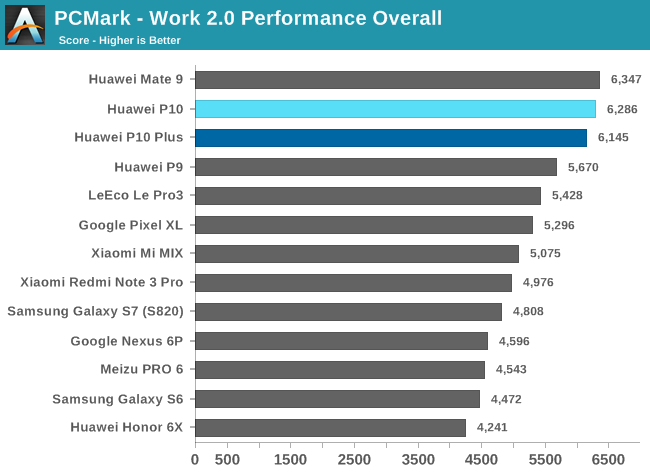
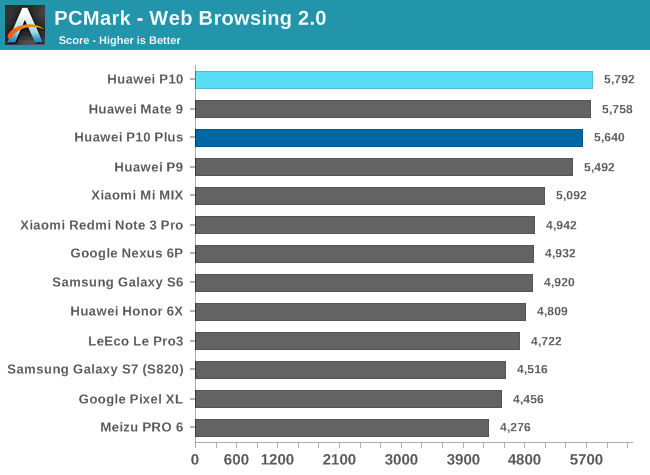
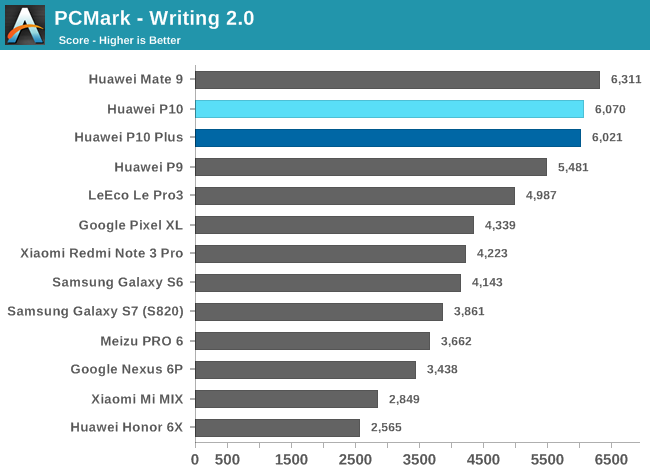
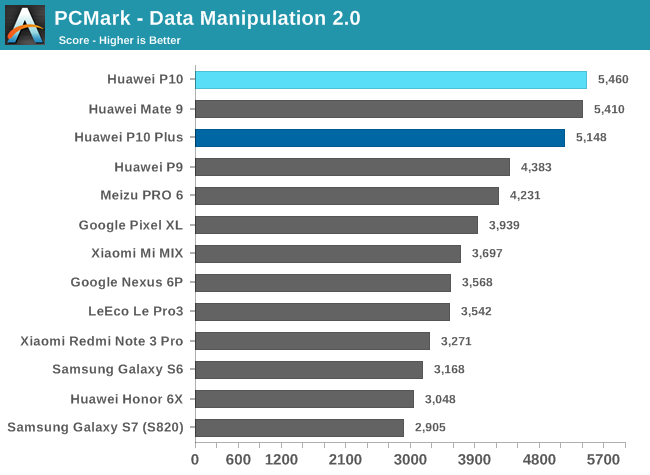
As expected, there’s no significant performance difference between the P10, P10 Plus, and Mate 9 in any of the PCMark Work 2.0 tests. All three phones post excellent results, with the P10 outperforming the older P9 and its Kirin 955 SoC by 11% overall.
There is not much difference between Huawei’s current generation flagships and last year’s P9 and Mate 8 in the Web Browsing test. The P10 Plus holds a slim 11% lead over Xiaomi’s Mi MIX and its Snapdragon 821 SoC, which grows to a more significant 27% lead over the Galaxy S7 and Pixel XL.
The Writing test is characterized by frequent but short bursts of activity that benefit from running on the big CPU cluster. While CPU IPC and frequency are important here, so is the phone’s proclivity to migrate threads onto the big cores. Huawei’s phones perform well once again in this test, with the P10 maintaining its roughly 11% advantage over the P9. There’s significantly more variation among the other phones in the chart, with the Mi MIX landing near the bottom at only half the performance of the P10. The Pixel XL trades places with the MIX in this test, but is still outperformed by the P10 by about 40%.
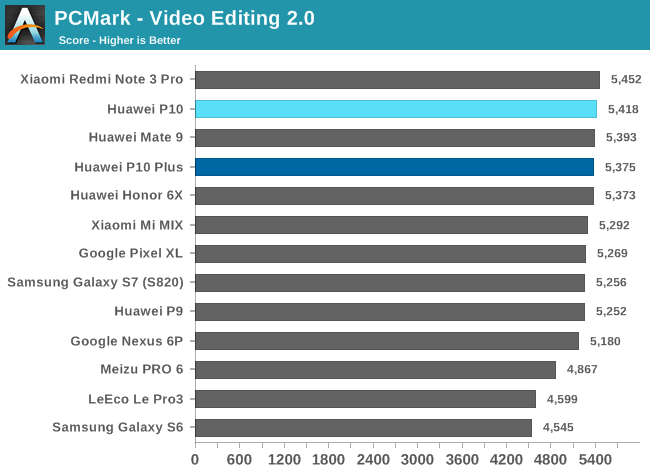
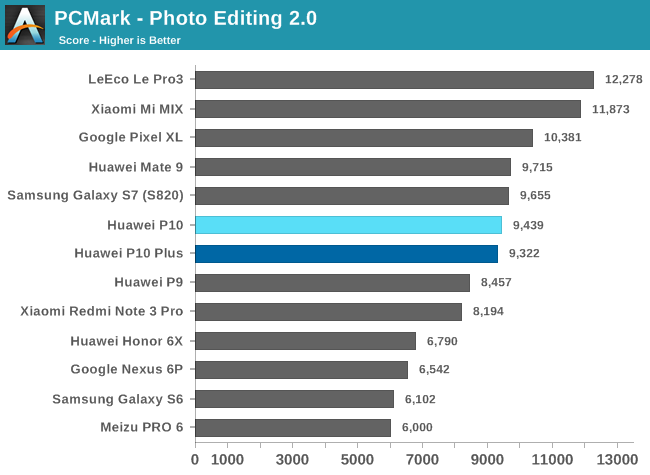
The PCMark Video Editing test is not particularly strenuous, so most phones perform about the same. The Photo Editing test, which uses both the CPU and GPU for applying various photo effects, produces more interesting results. It’s the only PCMark test where Huawei’s phones do not finish on top. Instead, phones using Snapdragon 820/821 SoCs and Qualcomm’s Adreno 530 GPU perform the best when running these workloads. The P10 holds a slim 12% advantage over the P9, but the Snapdragon 821 powered Le Pro3 is 30% faster.
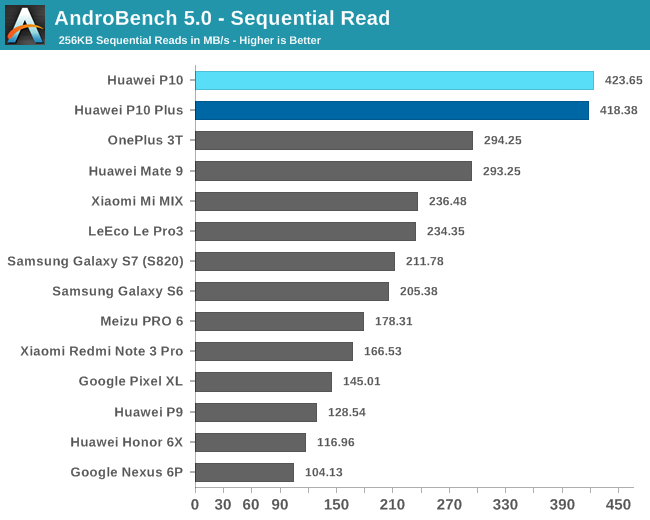
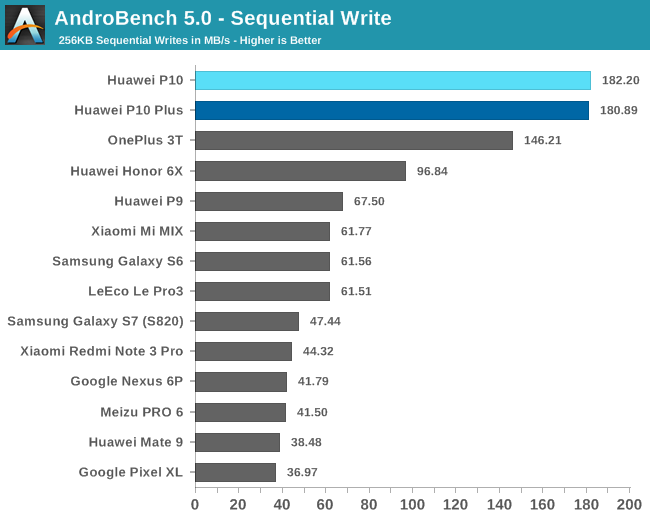
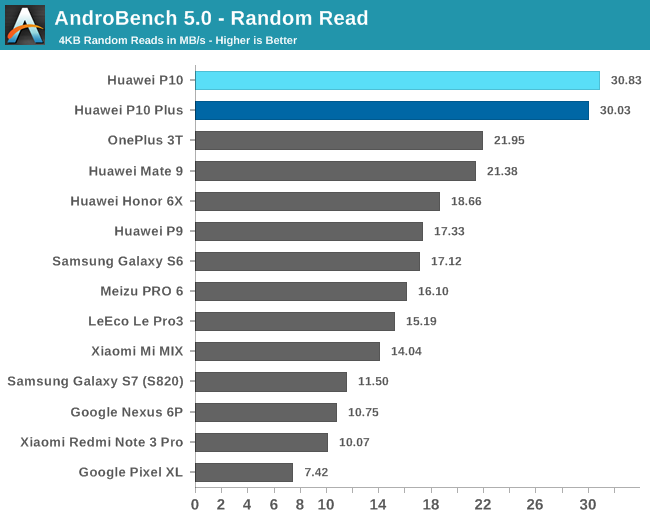
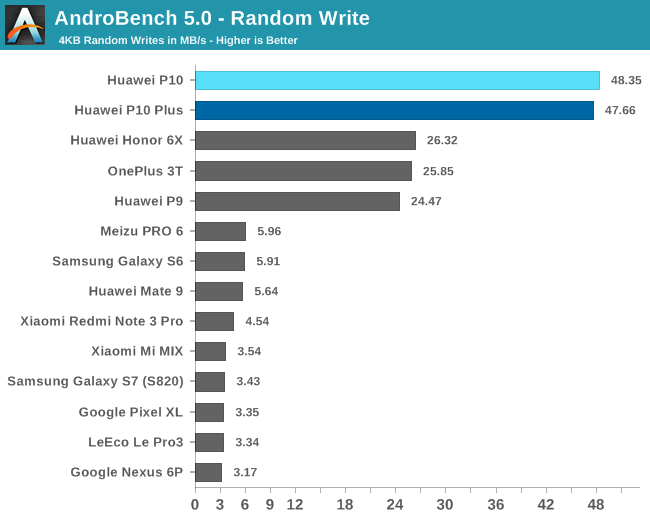
Obviously there is nothing wrong with storage performance for our P10s. Both the P10 and P10 Plus post excellent (and essentially identical) sequential and random throughput values. It’s also worth noting that both units are using UFS 2.0 NAND from Samsung.
The P10s easily outperform the Mate 9, especially when writing data sequentially or randomly. This particular Mate 9 is using UFS 2.0 NAND from Toshiba, which illustrates an important point: Just because a phone uses UFS 2.0 or 2.1 NAND does not mean it will perform well. Storage performance is multi-layered, starting with the operating system kernel and eventually ending at the storage controller and NAND itself. Even the underlying filesystem makes a big difference, with the P10, P10 Plus, P9, Mate 9, and OnePlus 3T all using the better performing F2FS (Flash-Friendly File System) for the /data partition instead of the default EXT4 file system.
With all of these variables in play, it’s impossible to even say that UFS NAND is always faster than eMMC NAND. For example, the Huawei P9, which uses eMMC 5.1 NAND, outperforms the newer Pixel XL and its UFS NAND in all but the sequential read test. The P9 also outperforms the Mate 9 in both writing tests. Now this does not mean a P10 with eMMC 5.1 NAND would perform the same or better than the two UFS examples we tested (it would not be able to match the sequential numbers at least), but it is important to take a step back and see the bigger picture.
| Storage Performance (AndroBench 5.0) | ||||||||
| Seq. Read (KB) |
Seq. Write (KB) |
Random Read (KB) |
Random Write (KB) |
|||||
| 1024 | 2048 | 1024 | 2048 | 8 | 16 | 8 | 16 | |
| Huawei P10 | 499.35 | 541.97 | 185.50 | 185.18 | 55.73 | 96.00 | 84.86 | 139.32 |
| Huawei P10 Plus | 516.78 | 558.45 | 182.24 | 183.15 | 53.22 | 93.37 | 82.52 | 137.51 |
| Huawei Mate 9 | 429.17 | 480.07 | 74.60 | 100.01 | 38.81 | 66.27 | 10.77 | 16.99 |
| Huawei Honor 8 | 169.07 | 198.77 | 83.65 | 102.45 | 30.2 | 46.25 | 17.17 | 26.59 |
The table above shows how storage performance scales with larger IO sizes. While the values we use in our general tests above represent the most common IO sizes, other workloads, notably accessing media files like photos and video, will utilize larger IO transfers, so it’s important to see how a phone performs over a wider range of scenarios. Sequential read throughput for the P10s continues to scale as expected, maintaining their lead over the Mate 9. Sequential write performance does not scale any further and only maintains its already high values. The Honor 8, which uses eMMC 5.1 NAND like the P9, manages to outperform the Mate 9 when writing sequentially or randomly at any IO size.
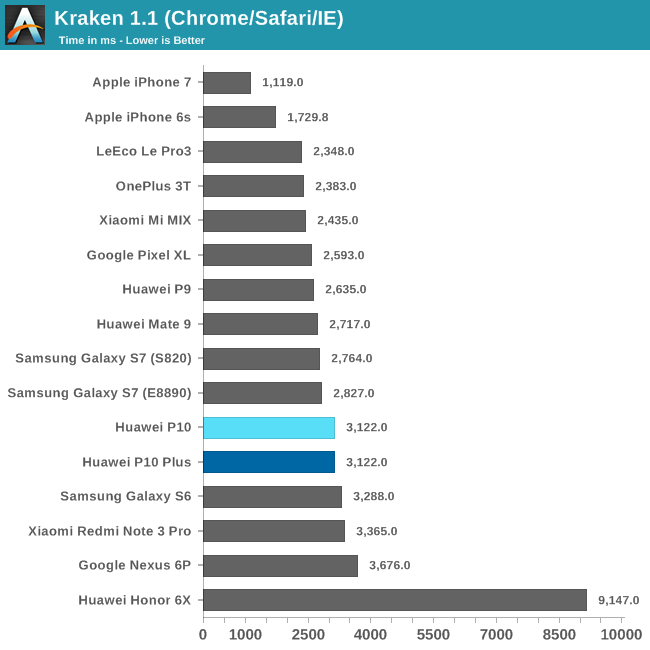
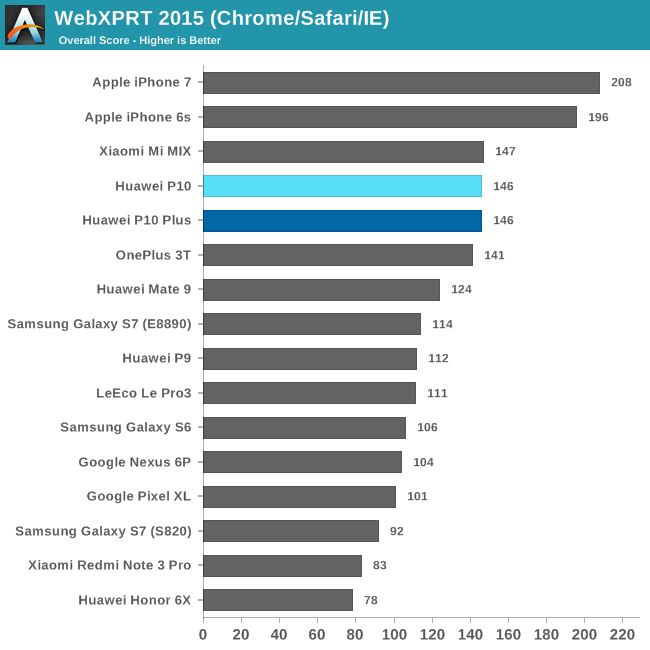
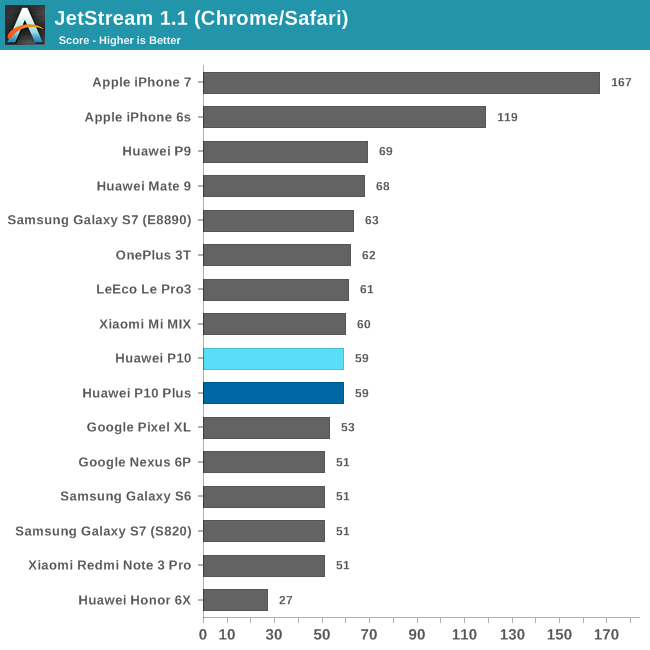
In the Kraken JavaScript test, both P10s fall behind the Mate 9 by 15%. The P10’s A73 CPU cores also cannot match the performance of the higher frequency A72s in the P9’s Kirin 955 SoC, or the custom Kryo cores in the Snapdragon 820/821 devices. The P10s do outperform the less-expensive Honor 6X by a factor of three, highlighting the performance deficit of using octa-core A53 CPU configurations instead of pairing the A53 cluster with 2-4 big out-of-order CPU cores.
Finishing positions flip in WebXPRT 2015, with the P10s out in front of the Mate 9 by 18% and the P9 by 30%. Scores in JetStream show less variation, but the P10s fall behind the Mate 9 and P9 once again by 17%.
The tests above corroborate my own subjective experience with the P10: It’s fast. Common tasks such as installing or opening apps, switching between running apps, and searching through my email inbox complete quickly. The redesigned EMUI 5.1 UI is smooth and responsive—not Pixel XL smooth, but flagship smooth.










74 Comments
View All Comments
drajitshnew - Saturday, May 13, 2017 - link
Bravo, that is a brilliant suggestion. Intel does it, AMD does it, nvidia does it, everybody does it. Bin it. The customer is happy, the reviewers don't get accused of anything, and you sell every part that you produce.Bondurant - Wednesday, May 17, 2017 - link
You want a lower price ? So whats the price difference between a UFS 2.1/2.0 and eMMC ? You want that deducted from the overall price ? Lol.zodiacfml - Friday, May 12, 2017 - link
Their market wouldn't bother or notice anyway. They have been making pretty, slim phones which allowed them to reach their current status.Stochastic - Friday, May 12, 2017 - link
Sometimes I wonder how much better consumer tech could be if everyone were as discriminating as Anandtech readers.Eden-K121D - Friday, May 12, 2017 - link
Aesthetics aside. Consumer Tech would be substantially better in terms of Technological advancementaparangement - Saturday, May 13, 2017 - link
I think the comparison to Google Pixel on i/o performance is somehow biased, I remember the storage of Pixel is encrypted by default, at least according to Google...https://blog.google/topics/connected-workspaces/pi...
Matt Humrick - Sunday, May 14, 2017 - link
The P10 uses full-disk encryption, while (I believe) the Pixel uses file-based encryption.ePambos - Saturday, May 13, 2017 - link
I am sorry to report that my Huawei P10 exhibits very different real life battery behaviour than your findings may suggest... As a previous owner or three (3!) Huawei P9 devices I can without any doupt say that they had better battery life than my current P10 that barely gets me through two days of very minimal use. Further more, my Huawei P10 (running factory Android 7.0) shows sudden drops of battery percentage when the phone is idle, or during nighttime even though I carefully configured all apps to be deactivated when screen is off etc. I have a very certain feeling that the idle power consumption of this device is absolutely ridiculous and maybe Huawei should tone down the performance of their processor for every day use in future updates for this phone and let users opt for an extreme/gaming performance mode only when necessary... So far, both camera performance and battery stamina have been dissapointing in comparison to the previous model (P9) which was an excelent device overall...Matt Humrick - Saturday, May 13, 2017 - link
Sorry to hear about your battery life issues. Do you see the same drop overnight if you put the phone in airplane mode? Maybe there's a signal strength issue causing the phone to burn more power.Trixanity - Saturday, May 13, 2017 - link
According to Notebookcheck, both P10 and P9 have an average idle power consumption of 2.1W and 2.37W respectively whereas Galaxy S7 (Exynos) and iPhone 7 have 1.02W and 1.51W respectively. Average load being 6.57W, 3.09W, 4.73W and 3.75W in the same order.It seems like Huawei/HiSilicon have problems with power management and I'm not referring to the out-of-control overclocked Mali G71 on the K960 (I'd bet the maximum of 9.32W would be considerably lower if clocked below 800 MHz or even 900).
Can you corroborate that? Does HiSilicon have a problem that other chip manufacturers do not? Or is it just bad software optimization causing unnecessary load? Do you have other power consumption figures?